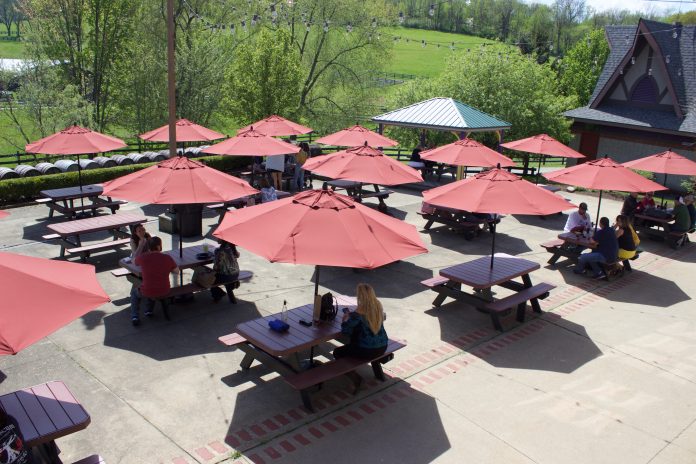
At Breitenbach Winery, in Dover, Ohio, May 16, customers gathered on the outdoor patio. Some wore hats and sunglasses. Some wore masks. But most had one thing in common.
“Everybody’s so happy and excited to get back outside and just come in and be human again,” said Dalton Bixler, owner.
After two months of curbside, carry-out and deliveries, restaurants, wineries, breweries and other agritourism businesses were able to reopen outdoor dining space to customers May 15.
Signs of the pandemic remain, with indoor floors marked to help customers social distance as they wait in line to order. Employees wear masks as they serve customers. There’s more hand sanitizer at tables and more frequent cleaning. In some businesses, plexiglass shields workers and customers from each other at cash registers.
Josh Dunn, one of the owners of Birdfish Brewing Co., in Columbiana, was up until midnight on May 15 putting markers on the floor before reopening the patio the next day. Until indoor dining opens May 21, Birdfish customers will come inside only to order, and then can move to outdoor seating.
“It’s not a grand reopening,” Dunn said earlier in the week. “We want people to feel comfortable with coming in. We don’t want them to feel unsafe.”
New guidelines
There are still challenges and new guidelines. Servers have to wear masks. Seats in dining areas have to be spaced apart.
Birdfish’s capacity will be down 50%, Dunn said.
Wineries and breweries also cannot bring back live music and games yet. Birdfish removed the pinball machine it usually has inside.
Inside the winery, where customers order, Bixler said he can safely have about 30 people at once. Before the pandemic, it wasn’t unusual to have more than 100 customers inside at once.
At Debonne Vineyards, in Madison, indoor capacity will be down to 35-40%, owner Tony Debevc said.
“It’s gonna be expensive,” he said, adding that for newer or less financially-sound businesses, the combination of the shut down and the new regulations for reopening could make it hard to survive.
Customers
Even with businesses opening, it’s hard to predict how long it will take for some customers and tourists to come back.
Bixler believes it will be about a 50/50 split. Some will rush to get back out, while others will still be cautious.
Debevc said he expects some will be eager to get back to wineries and restaurants, especially for outdoor dining. Others, however, may not feel comfortable going out yet. For those who are less comfortable, he said, it’s probably a good idea to wait a little longer.
He added it will take time for employees, as well as customers, to get used to the new rules. Servers will have to take extra time to clean tables. Some might be used to shaking hands and will have to adjust. Breaking those habits will take time.
“It’s not gonna be a perfect system right away,” Debevc said.

Interaction
Dunn said that before reopening Birdfish’s outdoor patio May 16, they trained employees on how to interact with customers and help people feel more comfortable. He’s hoping customers won’t have issues interacting with each other.
“There’s some that are not worried about health issues, and some that are,” Dunn said.
Both Bixler and Debevc also added that they were a little concerned about how people would react to the new restrictions. But, Bixler said, so far, on May 16, he hadn’t had any issues.

Sales
Throughout the shutdown, retail and wholesale were key for some businesses. Richard Kauffman, of Kauffman’s Country Bakery, in Millersburg, said retail was still only about 50% of what it usually is for him this time of year, but he is doing well on the wholesale side.
“Grocery stores seem to be booming,” he said.
With tourism still slow in the area, Kauffman isn’t getting orders from hotels and restaurants. The bakery also hasn’t added Sunday hours yet this year, like it usually does for tourist season.
Kauffman said it’s hard to know when the tourists will come back in force, but he expects it to take a while.
“The fear factor is pretty high, I’d say,” he added.
Debevc said his sales were strong through March and most of April, but started to fall off a little bit around the beginning of May. He believes this is because more wineries started adjusting to the shut downs and got more heavily into retail and wholesale, increasing the competition.
“It’s gonna be a very slow process going back,” Debevc said. “There’s no question about it.”
Despite all the challenges, Bixler views the situation as an opportunity to find new ways to improve.
“It kind of gave us all a wake up call,” he said. “Don’t get too comfortable in your shoes — you may have to change your shoes sometimes.”










